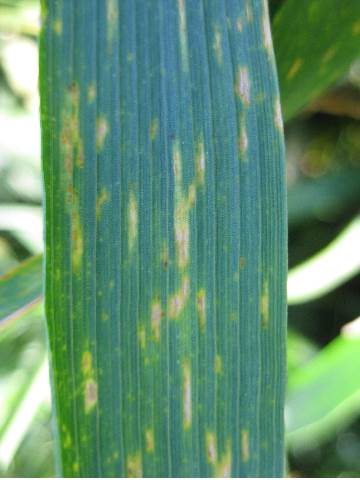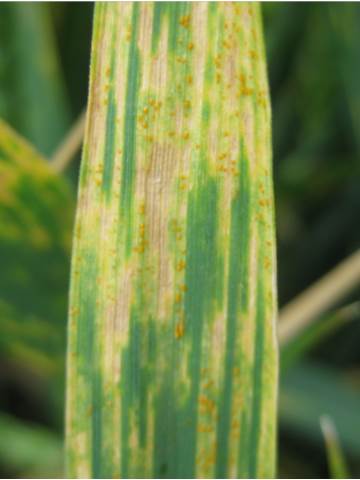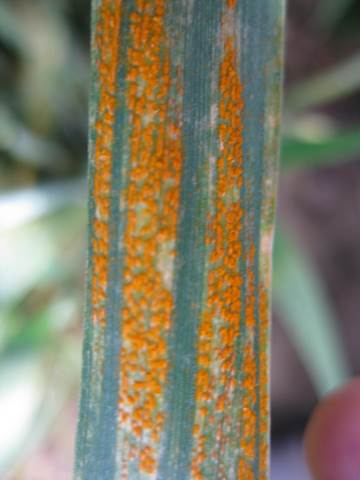Stripe Rust Update and Recommendations
Xianming Chen
We were checking wheat and barley fields in Garfield, Columbia, Whitman, and Spokane counties in Washington and Latah County in Idaho yesterday and today. Stripe rust was widespread. Infection of various levels was found in almost all fields checked. Most fields had below 10% of severity and below 20% incidents, mixing with resistant, moderately resistant, and susceptible reactions. Two winter wheat fields, (one west of Colfax and one north of St. John in Whitman County), had large “hotspots” with 100% of plants infected and 40-80% of severity in the hotspots. Varieties in these fields were not identified. Plants in these fields had mostly necrotic stripes with limited rust pustules, which could be due to moderate resistance or fungicide application. Such fields could have been sprayed earlier to reduce yield loss.
Because stripe rust started earlier in the Walla Walla and Dayton (Columbia County), I was able to take preliminary notes in the variety trial near Dayton. The stripe rust reactions of the most of tested varieties were as expected with some exceptions. Variety Rod had more susceptible plants than in the past, indicating a considerable proportion (estimated as 20%) of plants became susceptible. Similar, susceptible plants in ‘Tubbs 06’ became more than in the past a couple of years after the re-selection from ‘Tubbs’. Even with a moderately resistant reaction, ‘Lambert’ had very high severities (40-80%). The changes towards more susceptibility of these two varieties are not only due to the low temperature and high moisture conditions this year, but also possibly due to changes of races and their frequencies.
Based on the notes in this variety trial and previous data, the unique weather conditions, and HTAP resistance has started kicking in, I’d like to group the major varieties into the following three groups regarding fungicide applications:
Varieties should NOT be sprayed: Eltan, Madsen, Eltan/Madsen, Chukar, Finch, Skiles, ORCF-102, ORCF-103, Coda, Madsen/Rod, Legion, Bitteroot, Bruehl, Stephens, Brundage 96, Eltan/Tubbs06, KCF9002, RJames, Goetze, Goetze/Skiles, Cara, and George.
Varieties should be sprayed: AP Legacy, Salute, KCF9003, CDC Ptarmigan, Paladin, Eddy, Finley, Finway, and Buchanan.
Varieties can be either sprayed or not sprayed: Tubbs 06, Simon, Xerpha, Rod/Tubbs 06, Rod, Lambert, Masami, WB-528, AP700CL, Farnum, and Bauermeister. The difficulty to make a decision of spray or not spray for varieties in this group is due to the inadequate levels of HTAP resistance in some of these varieties under the cool and wet conditions and genetic mixtures within some of the varieties. Whether to spray or not spray should depend upon the location and yield potential. Under current situations, these varieties may be sprayed if they are grown in Walla Walla, Columbia, and Garfield counties and southwestern Whitman County as rust severity has reached to significant levels and expected to increase more in another week or so. In most of the other areas, rust levels are still quite low and we expect that HTAP resistance starts to work in most of these varieties as the weather is going to warm up next week. The second consideration is the yield potential. The higher yield potential, the easier to justify the cost of fungicide application. A general guideline is that fields of 100 bushel per acre should more toward spraying as yield losses of such varieties may range between 5 to 15%.
In addition to Tilt, Quilt, Quadris, Stratego, and Headline, Folicur can be used.
Growers start worrying about spring wheat. Spring wheat has a much wide variation in growth stages, from tillering to flag leaf stage. We saw rust in spring wheat fields, but in very low incidence and severity (less than 2%) in general. If susceptible varieties (such as Scarlet, Hank, Nick, Eden, Westbred 926, Tara 2002, Jefferson) are grown, you may
consider an early spray before rust reaches 10% severity or incidence as you may be able to use ground application in early stage. If resistant varieties (such as Louise, Wakanz) are grown, fungicides may not be used you should not use fungicides. Alpowa is in between and we hope its HTAP resistance starts working as the weather becomes warm.
We found a very low level of stripe rust on barley in a couple of fields in Whitman County, not warrant immediate spray. People should check their fields for stripe rust and its increase. If moderately resistant varieties (such as Baronesse and Bob), spray may not be necessary. If other varieties (mostly susceptible) are grown, spray may be needed in a week or two when rust reaches about 10% severity or incidence.
Stem rust
The rust samples we collected from barberry bushes in the Latah County Idaho and Whitman County, Washington last month have been identified as stem rust. We couldn’t found any stem rust in the wheat fields nearby the barberry bushes in the Latah County today. Rust reached late stage of aecial on the bushes.
To help you to tell among resistant, intermediate, and susceptible reactions, I attached some pictures below:
Resistant reaction (not sprayed):

Intermediate reaction (may or may not be sprayed):

Susceptible reaction (need to spray):
